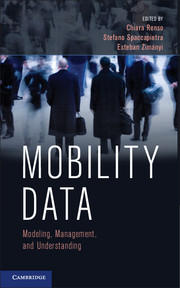Book contents
- Frontmatter
- Contents
- List of Contributors
- Preface
- Acknowledgments
- PART I MOBILITY DATA MODELING AND REPRESENTATION
- PART II MOBILITY DATA UNDERSTANDING
- PART III MOBILITY APPLICATIONS
- 10 Car Traffic Monitoring
- 11 Maritime Monitoring
- 12 Air Traffic Analysis
- 13 Animal Movement
- 14 Person Monitoring with Bluetooth Tracking
- PART IV FUTURE CHALLENGES AND CONCLUSIONS
- Bibliography
- Glossary
- Author Index
- Subject Index
- Plate section
11 - Maritime Monitoring
from PART III - MOBILITY APPLICATIONS
Published online by Cambridge University Press: 05 October 2013
- Frontmatter
- Contents
- List of Contributors
- Preface
- Acknowledgments
- PART I MOBILITY DATA MODELING AND REPRESENTATION
- PART II MOBILITY DATA UNDERSTANDING
- PART III MOBILITY APPLICATIONS
- 10 Car Traffic Monitoring
- 11 Maritime Monitoring
- 12 Air Traffic Analysis
- 13 Animal Movement
- 14 Person Monitoring with Bluetooth Tracking
- PART IV FUTURE CHALLENGES AND CONCLUSIONS
- Bibliography
- Glossary
- Author Index
- Subject Index
- Plate section
Summary
Maritime Context
The maritime environment still represents unexploited potential for modeling, management, and understanding of mobility data. The environment is diverse, open but partly ruled, and covers a large spectrum of ships, from small sailboats to supertankers, which generally exhibit type-related behaviors. Similarly to terrestrial or aerial domains, several real-time positioning systems, such as the Automatic Identification System (AIS), have been developed for keeping track of vessel movements. However, the huge amounts of data provided by these reporting systems are rarely used for knowledge discovery. This chapter aims at discussing different aspects of maritime mobilities understanding. This chapter enables readers to, first, understand the intrinsic behavior of maritime positioning systems and then proposes a methodology to illustrate the different steps leading to trajectory patterns for the understanding of outlier detection.
Maritime Traffic
The maritime environment has a huge impact on the world economy and our everyday lives. Beyond being a space where numerous marine species live, the sea is also a place where human activities (sailing, cruising, fishing, goods transportation, etc.) evolve and increase drastically. For example, world maritime trade of goods volume has doubled since the seventies and reached about 90% of global trade in terms of volume and 70% in terms of value. This ever increasing traffic leads to navigation difficulties and risks in coastal and crowded areas where numerous ships exhibit different movement objectives (sailing, fishing, etc.), which can be conflicting.
- Type
- Chapter
- Information
- Mobility DataModeling, Management, and Understanding, pp. 221 - 239Publisher: Cambridge University PressPrint publication year: 2013
- 1
- Cited by



